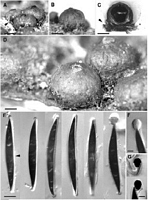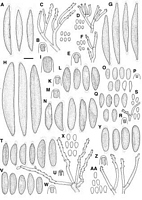|
 Rosellinia freycinetiae Rosellinia freycinetiae
BiostatusPresent in region - Indigenous. Endemic
Images (click to enlarge)
Caption: Fig. 14 Rosellinia freycinetiae. A, B, D, Stromata, A showing synnemata (arrow); C, Vertical
section of stroma, outer shell stroma, inner shell perithecium, rem | 
Caption: Fig. 8 A-D, Rosellinia arcuata, PDD 41969: A, Ascospores; B, Ascus apical ring; C,
Conidiophores and conidia on the host; D, Conidiophores and conidia on OA; E-G, R.
freycinetiae, PDD 20580: E, Ascus a |
Article: Petrini, L.E. (2003). Rosellinia and related genera in New Zealand. New Zealand Journal of Botany 41(1): 71-138 (http://www.rsnz.org/publish/abstracts.php).
Description: Subiculum persistent, woolly to felty appressed, with synnemata. Stromata (1500)1785 ±
185(2000) µm high, (2050)2180 ± 124(2375) µm wide (n = 5), globose to subglobose with
flattened top, copper brown, dark brown, black around the ostioles, solitary, crowded. Ostioles
finely papillate, poorly differentiated. Ectostroma up to 150 µm thick, black. Entostroma
cream, confined to sides and base, gradually reduced and absent in older material. Perithecia
detached and collapsed in mature material. Ascus apical rings 7.6-8.6 µm long, upper width
6.5-7 µm, lower width 4.8-5.7 µm (n = 3), J+, dark blue. Ascospores (52.8)61.7 ± 4.3(70) µm
long, (6.7)8 ± 0.5(8.6) µm wide (n = 30), inequilateral, narrowly ellipsoidal to needle shaped,
with narrowly rounded ends, brown, with straight, 9-12 µm long germ slit centred on the flat
side, both extremities and flat side surrounded by a slimy sheath, 2-3 µm thick at ends, 1 µm
thick at side. Synnemata 500- 1000 µm high, conidia 4-5.5 x 2.5-3 µm.
ANAMORPH: Dematophora.
Habitat: HOST: Freycinetia baueriana subsp. banksii.
MATRIX: Decorticated, heavily decomposed wood.
Notes: ETYMOLOGY: Referring to the host plant.
NOTES: Rosellinia freycinetiae exhibits the typical character combination of Rosellinia spp.
with a Dematophora anamorph: large, coarse stromata and arge, slender ascospores with a
short germ slit and both extremities and flattened side surrounded by a slimy sheath. It can be
distinguished from R. arcuata and R. necatrix by its larger ascospores and from R. gigantea
and R. pepo by its smaller stromata, being about half the size of the stromata of the two latter
species. For a discussion on the differences from other related species, see R. arcuata.
|